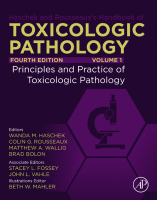Physical Address
304 North Cardinal St.
Dorchester Center, MA 02124

1 Introduction Traditionally trained veterinary and medical pathologists often encounter unanticipated challenges during their transition from diagnostic pathology to the regulatory-driven environment of toxicologic pathology. During their initial years of training and diagnostic effort, pathologists typically serve both clinical and…

Acknowledgments The authors would like to thank David Sabio and Experimental Pathology Laboratories for assistance with figure generation. We foresee cancer research as an increasingly logical science, in which complexities are manifestations of a small set of underlying organizing principles.…

1 Introduction Developmental and reproductive toxicity (DART) studies represent an important component of the toxicology programs supporting both the development of novel therapeutics and the evaluation of environmental, agricultural, and industrial chemicals. Reproductive toxicity generally refers to adverse effects on…

1 Introduction 1.1 Importance of Morphologic Assessment in Toxicologic Pathology Microscopic morphologic assessment is a major component of experimental toxicity studies using laboratory animal models. To realize the full value of these studies, toxicologic pathologists should accurately classify all adverse…

1 Introduction: Definition of Pharmacodynamics and Toxicodynamics In simple terms, pharmacodynamics (PD) and toxicodynamics (TD) describe the relationship between exposure (concentration at the site-of-action) of the drug, toxicant, or toxin (xenobiotic) and the extent of resulting effect on the body…

1 Introduction Large molecules therapeutics, also referred to as biologics or biotherapeutics, are proteins designed to modulate their target(s) pharmacology to achieve therapeutic effect. The key advantage that biotherapeutics offer is their high target specificity, which makes them ideal modalities…

Acknowledgments The following individuals have provided valuable insights to this book chapter: Trent Abraham, Kenneth Cassidy, Gemma Dickinson, Timothy Jones, Bridget Morse, Everett Perkins, Maria Posada, John Vahle, and Lian Zhou. 1 Introduction As new medicines are being developed to…

1 Introduction This chapter provides an overview of the fundamental principles of toxic mechanisms of injury. It is focused on biochemical, cellular, and molecular mechanisms that contribute to toxicity. Additionally, xenobiotic disposition, representing the integrated action of absorption, distribution, biotransformation, and…

1 An Overview of Toxicologic Pathology Citizens of industrialized societies generally have enjoyed a rising standard of living since the dawn of the Industrial Age in Great Britain during the mid-18th century and in other countries thereafter. This time of…